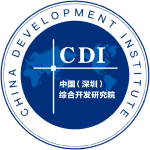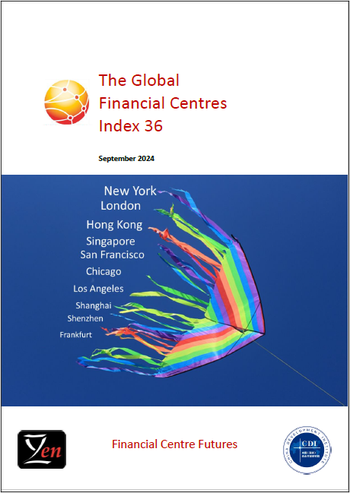Authors
Mike Wardle, Professor Michael Mainelli
Published by
Long Finance & Financial Centre Futures (September 2024), 61 pages. Produced by Z/Yen in partnership with CDI.
Share on social media:


The Global Financial Centres Index 36
The thirty-sixth edition of the Global Financial Centres Index (GFCI 36) was published on 24 September 2024. GFCI 36 provides evaluations of future competitiveness and rankings for 121 financial centres around the world. The GFCI serves as a valuable reference for policy and investment decision-makers.
China Development Institute (CDI) in Shenzhen and Z/Yen Partners in London collaborate in producing the GFCI. The GFCI is updated and published every March and September, and receives considerable attention from the global financial community.
133 financial centres were researched for GFCI 36 of which 121 are in the main index. The GFCI is compiled using 143 instrumental factors. These quantitative measures are provided by third parties including the World Bank,, the OECD, and the United Nations.
The instrumental factors are combined with financial centre assessments provided by respondents to the GFCI online questionnaire. GFCI 36 uses 37,830 assessments from 6,188 respondents.
GFCI 36 Results
Leading Centres
- New York leads the index, with London second. Hong Kong has overtaken Singapore to regain third position.
- San Francisco remains at number five, with Chicago and Los Angeles overtaking Shanghai to place sixth and seventh, with Shanghai now in eighth position.
- Shenzhen and Frankfurt complete the top 10.
Western Europe
- London continues to lead in the region in second place globally, with seven Western European centres featuring in the top 20 in GFCI 36.
- The average rating across this region was a reduction of just over 1% - the biggest fall in ratings among the regions.
- Dublin, Lugano, Jersey, Guernsey, and the Isle of Man gained nine rank places or more in comparison with GFCI 35.
Asia/Pacific
- Seven Asia/Pacific centres feature in the world top 20, and the average rating for this region is down 0.56%.
- Rankings in the region were relatively stable, although Sydney, Nanjing, and Tianjin fell 10 places or more. Kuala Lumpur was the only centre in the Asia/Pacific region that improved more than 10 places in GFCI 36.
North America
- New York, San Francisco, Chicago, and Los Angeles remain in the world top 10, with Washington DC also in the top 20.
- On average, ratings for centres in this region fell 0.38%.
- Montreal rose six rank places, the largest rise in the region.
Eastern Europe & Central Asia
- Astana remains in the lead position in the region, up four rank places to 62nd.
- Almaty overtook Tallinn to take second place in the region.
- The average rating change across this region was a fall of just 0.13%.
- Almaty rose 12 rank places, with Tallinn down 10 places. All other centres had changes in their rankings of fewer than 10 places.
Middle East & Africa
- Dubai and Abu Dhabi continue to take first and second places in the region, with Dubai rising four rank places to 16th in GFCI 36.
- Tel Aviv remains third in the region, with Casablanca the leading African centre and fourth in the region.
- The average rating change across this region was a fall of just 0.01%.
- Riyadh and Doha reversed the falls they experienced in GFCI 35, both up over 20 places. Kuwait City improved 11 rank places.
Latin America & The Caribbean
- Bermuda rose dramatically—up 27 places in GFCI 36 to lead the region, with Cayman Islands and Sao Paulo in second and third places.
- Bahamas rose eight rank places.
- This region was the only world region where the average rating in the index increased - by 0.65%.
FinTech
- We are able to assess 116 centres for their Fintech offering.
- New York retains its leading position in the Fintech ranking, followed by London. Shenzhen overtook San Francisco to take third position by just one rating point.
- Hong Kong has joined Washington DC, Los Angeles, Chicago, Singapore, and Seoul in the top 10, replacing Shanghai, which has dropped to 15th position.
- In the Fintech rankings, 12 centres dropped 10 or more places with 9 centres rising 10 or more places.




